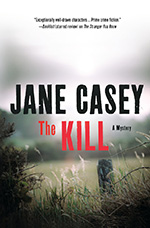Paula Hawkins: The Girl on the Train
 It’s always puzzling to me why a particular book takes off for the stratosphere, and another, equally good, does not, but there’s no denying the popularity of Paula Hawkins’ debut, The Girl on the Train. While I’ve heard Hawkins say in an interview that no one ever thought of a character seeing a crime from a train before (see The 4:50 from Paddington, Agatha Christie, 1957), I have also seen an interview in the New York Times Book Review where she mentions a reverence for Ruth Rendell. There are also articles talking about this novel being responsible for the “re-birth”of domestic suspense, a trend that has always been with us, going back, again, to Agatha herself. All that made me unwilling and uninterested in reading it, but I put it on our book club ballot and the book club picked it, so here I am, having read the most popular novel published in the last few years.
It’s always puzzling to me why a particular book takes off for the stratosphere, and another, equally good, does not, but there’s no denying the popularity of Paula Hawkins’ debut, The Girl on the Train. While I’ve heard Hawkins say in an interview that no one ever thought of a character seeing a crime from a train before (see The 4:50 from Paddington, Agatha Christie, 1957), I have also seen an interview in the New York Times Book Review where she mentions a reverence for Ruth Rendell. There are also articles talking about this novel being responsible for the “re-birth”of domestic suspense, a trend that has always been with us, going back, again, to Agatha herself. All that made me unwilling and uninterested in reading it, but I put it on our book club ballot and the book club picked it, so here I am, having read the most popular novel published in the last few years.
 Jane Casey has developed into one of the more reliable police procedural writers around. This is a bravura effort from her, seven books into her series about Detective Maeve Kerrigan, the vagaries of her love life, and her fellow detective, the irascible Josh Derwent. Tackling a fire that breaks out in a housing project (or as the Brits call them, Housing Estates, a fancier term for the same thing), Casey highlights various people who live on the estate, couched mostly in heartbreaking terms. Things only get worse after the fire.
Jane Casey has developed into one of the more reliable police procedural writers around. This is a bravura effort from her, seven books into her series about Detective Maeve Kerrigan, the vagaries of her love life, and her fellow detective, the irascible Josh Derwent. Tackling a fire that breaks out in a housing project (or as the Brits call them, Housing Estates, a fancier term for the same thing), Casey highlights various people who live on the estate, couched mostly in heartbreaking terms. Things only get worse after the fire. I loved Judith Flanders’ first Sam Clair novel, A Murder of Magpies, and I may have liked this one even more, as some of her plotting was clearer than it was in the first novel. In truth, though, that part didn’t matter so much to me. What I really love is the setting – Sam is a 40-something book editor in London – and in this novel she’s caught up by the apparent suicide of the business partner of one of her dear friends. The friend and his partner own(ed) a London art gallery specializing in a well known pop artist (Flanders creates an artist who would have been a contemporary of Lichtenstein and Warhol) and then she plunges the action full bore into the world of publishing and art and where the two sometimes collide.
I loved Judith Flanders’ first Sam Clair novel, A Murder of Magpies, and I may have liked this one even more, as some of her plotting was clearer than it was in the first novel. In truth, though, that part didn’t matter so much to me. What I really love is the setting – Sam is a 40-something book editor in London – and in this novel she’s caught up by the apparent suicide of the business partner of one of her dear friends. The friend and his partner own(ed) a London art gallery specializing in a well known pop artist (Flanders creates an artist who would have been a contemporary of Lichtenstein and Warhol) and then she plunges the action full bore into the world of publishing and art and where the two sometimes collide.




